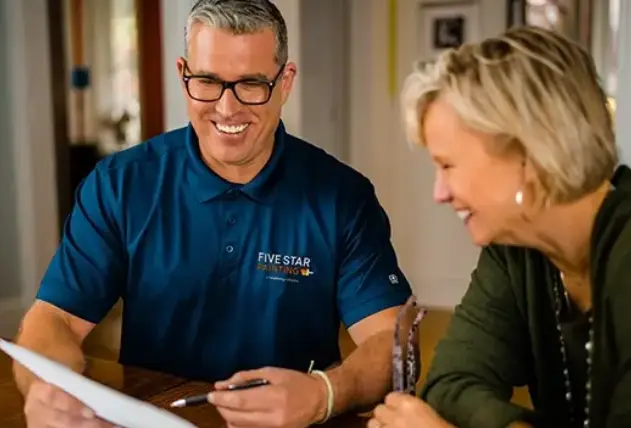Five Star Painting provides a comprehensive guide to garage floor painting that covers essential steps for a durable, attractive finish.
|
Is your garage floor finish looking a little worse for wear? Whether you're looking to boost your curb appeal, add some personality to your workspace, or simply protect your garage floor, this guide provides the essential steps. From prepping surfaces, choosing the right paint, application techniques, and even some troubleshooting tips, we’ll get your painting project started.
Materials and Tools Checklist
By gathering all the necessary materials and tools before you begin, you'll streamline the garage floor painting process and avoid any frustrating delays. Here’s the list of what’s required:
Safety and Comfort Gear:
- Safety glasses
- Gloves
- Dust mask
- Respirator (for strong chemicals such as etching solution)
- Knee pads
- Disposable coveralls to protect clothes
- Well-ventilated space (fans recommended)
Cleaning Supplies:
- Stiff-bristled push broom
- Degreaser for concrete
- Stain removers
- Concrete neutralizer
- Shop vac (wet/dry)
- Rags
Surface Repair and Etching:
- Concrete crack filler
- Wire brush or scraper
- Putty knife or trowel
- Sandpaper or grinding stone (for smoothing after filling cracks)
- Concrete etching solution (designed for garage floors)
- Sprayer or paint roller (for applying etching solution)
Painting Supplies:
- High-quality epoxy floor paint
- Paint roller cage and frame (extendable handle recommended)
- Roller sleeves
- Paint tray liners (disposable liners for easy cleanup)
- Mixing bucket and stir stick
- Drop cloths or plastic sheeting (to protect surrounding areas)
- Masking tape
- Flakes or chips
- Epoxy sealer (optional for extra protection and shine)
Preparing Your Garage Floor
A clean, well-prepped surface is the key to ensuring maximum adhesion and a durable, long-lasting paint job. Before you reach for your roller, you must do all the following:
Cleaning and Surface Preparation
1. Clear the Canvas:
- Start by removing everything from your garage: This includes tools, furniture, and any other items that might get in the way.
- Sweep and vacuum thoroughly: Get rid of all loose dirt, dust, and debris. Pay close attention to corners and cracks.
2. Degrease, then Deep Clean:
- Oil stains and grime are the enemy of good adhesion: Use a powerful degreaser specifically formulated for concrete to tackle these stubborn spots. Follow the manufacturer's instructions for application and rinsing.
- Deep clean: Use a concrete cleaner to remove any remaining dirt, grease, and contaminants. Always wear gloves and eye protection when using these products.
-
Small cracks can become big problems later: Inspect your garage floor for cracks and chips. Use a concrete patching compound to fill in any imperfections. Ensure the patching material is rated for use on garage floors and cures completely.
4. Etch it Out:
-
Concrete can be naturally glossy: To ensure proper paint adhesion, you'll need to etch the surface slightly. Use a concrete etcher according to the product's instructions. This will create a slight texture that the paint can grip onto.
5. Neutralize and Rinse:
- Once you've etched the floor, it's crucial to neutralize the surface: Use a neutralizing solution as recommended by the etcher manufacturer. This will stop the etching process and prepare the floor for paint.
- Finally, rinse the entire floor thoroughly with clean water: Remove all traces of cleaning products, etcher, and neutralizer. Let the floor dry completely before proceeding – this can take 24-48 hours depending on weather conditions.
DIY Red Flag: If the floor isn't properly cleaned and prepped, the paint won't stick well and will peel or chip easily, which means a lot of time is spent removing old paint and grime before you can even start painting.
Bonding Primer Basics
After you’ve etched the concrete, it’s time to apply a bonding primer. It adds an extra step to the process, bonding primer is completely necessary for a long-lasting garage floor. If this seems too complicated, consult with a professional. Create a stronger bond between the concrete and the paint, maximizing durability and preventing peeling by:
- Apply a thin, even coat of the primer using a paint roller with a short nap.
- Allowing the primer to dry completely according to the manufacturer's instructions, typically around 4-6 hours.
Pick Your Paint
Not all paints are created equal, especially for a high-traffic area such as your garage floor. Choosing the right paint type is difficult without the right insight, so reach out to a professional painter. Below are some tips to get you started:
- Epoxy Paint: A solid choice for added durability and resilience. Epoxy creates a tough, chemical-resistant finish that withstands heavy traffic, hot tires, and even occasional spills of harsh chemicals. However, epoxy paints require meticulous surface preparation, have strong fumes during application, and can be more expensive than other options are (so a professional’s help is your best route).
- Acrylic Paint: Acrylic paints are less durable than epoxy paints are, susceptible to scratches and peeling, and might not hold up well under heavy use or constant moisture exposure. Experts in floor coatings typically discourage the use of acrylic paint for garage floors.
- Polyurethane Paint: Offers a good balance between affordability and durability. Polyurethane is more resistant to scratches and wear than acrylics are, but are not quite as tough as epoxy is. Getting proper coverage that resists peeling is a job better suited for professional painters.
Textured Sprinkles and Anti-Skid Additives
While a freshly painted garage floor looks amazing, it can also become slippery, especially when wet. Here's where textured sprinkles and anti-skid additives come in:
- Textured Sprinkles: These tiny colored flakes come in various colors and can be added to the paint during the second coat. They create a slightly rough texture that enhances traction and adds a decorative touch.
- Anti-Skid Additives: For an invisible layer of safety, consider adding anti-skid additives to your paint. These additives provide extra grip without affecting the overall finish of the paint.
DIY Red Flag: If you choose the wrong type, (latex paint) it won't hold up to the wear and tear of a garage floor. You'll need to return to the hardware store for a special high-durability concrete paint or epoxy coating.
Step-by-Step Garage Floor Painting Guide
It's now time to roll up your sleeves and transform your garage floor finish. To achieve a professional-looking, finished product start by:
Priming and Painting
Applying a bonding primer before painting creates a superior bond between the concrete and the paint, maximizing durability and preventing peeling down the line. If you plan on a DIY approach make sure that you:
- Prioritize Cleaning: Ensure your floor is completely clean, dry, and free of dust or debris after etching and neutralization.
- Move Smoothly: Maintain a smooth and consistent rolling motion, applying the primer and/or paint in straight strokes with slight overlap (avoid overloading the roller).
- Account for the Edges: Use an angled paint brush to “cut in” (create sharp lines) the paint along the baseboards and wall edges for a clean, finished look.
- Make Time to Dry: Allow the paint to dry completely according to the manufacturer's instructions, typically around 4-6 hours.
DIY Red Flag: Paint dries quickly, so you need to work fast to avoid lap marks and uneven drying on a large surface such as a garage floor, which can be hard to handle for one person.
Addressing an Uneven Application
While striving for a smooth and even application, bumps or streaks can happen. Begin buffing for:
- Light Unevenness: For minor imperfections, wait for the paint to dry completely. Then, use fine-grit sandpaper to lightly sand down the uneven areas. No need to sand the entire floor, just the high spots. Clean the area and apply a light touch-up coat if needed.
- Significant Unevenness: For more serious unevenness, you need to address the entire painted surface. Scrape away any loose or high-paint areas. Re-sand the entire floor and repaint it completely, following all the preparation steps again.
Prevention Tips:
- Use a high-quality paint roller with a nap size appropriate for your chosen paint.
- Maintain a consistent rolling technique, applying the paint in smooth and even strokes with slight overlaps.
- Ensure the paint isn't too thick when applying it. Multiple thin coats are better than one thick coat, which can lead to dripping and unevenness.
- Adequately light your workspace so you can easily see any areas that might require extra attention during application.
- Test for moisture wicking by using a small sheet of plastic laid out on the dry floor for 48 hours to test for water wicking. This is one of the main reasons for future failings of coatings.
DIY Red Flag: Concrete floors aren't always perfectly smooth, and getting an even coat of paint can be tricky - leading to a blotchy or streaky finish.
A Professional Touch, Start to Finish
Garage floor painting is rewarding but also requires you to make room in your schedule (and extra trips to the hardware store). From careful preparation to the final coat, Five Star Painting® will refresh your garage floor properly without adding another weekend project into the mix. With our Neighborly Done Right Promise™, we also make sure any painting project is done right the first time.
Our Painting Process
When you choose Five Star Painting for your garage floor coating, you get more than just a paint job – our process includes:
- Free Estimate: Our experts will visit your home to assess your garage floor, answer your questions, and provide a customized quote.
- Careful Preparation: We prepare the floor surface, ensuring optimal paint adhesion for a long-lasting finish.
- Quality Products: We use only the highest-quality epoxy floor paints and coatings designed to withstand heavy traffic and chemical spills.
- Expert Application: Our skilled painting professionals ensure an even coat of paint, transforming your garage floor.
- Project Clean-Up: We leave your garage clean and spotless, ready for you to enjoy your beautiful new space.
Ready to restore your garage floor finish?
Get a free estimate from Five Star Painting today!


